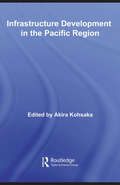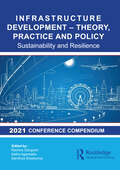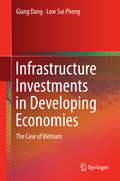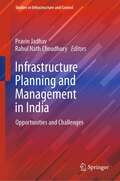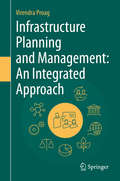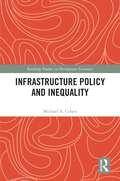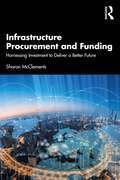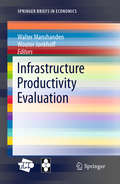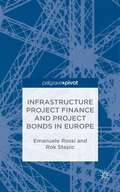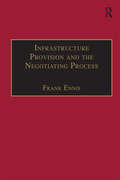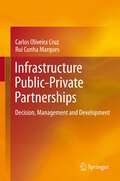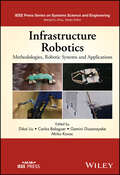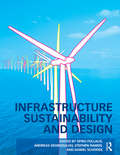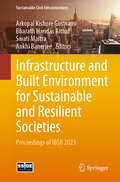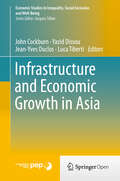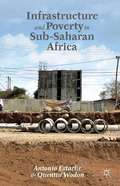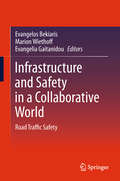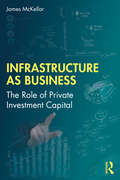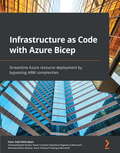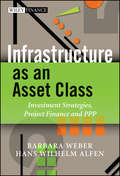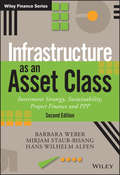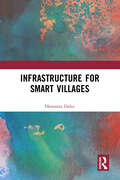- Table View
- List View
Infrastructure Development in the Pacific Region (Routledge Studies in International Business and the World Economy)
by Akira KohsakaIn the past, undersupply of public infrastructure was blamed for low productivity growth in the United States in the 1970s, while greater private sector participation was emphasized for infrastructure development in the Asia-Pacific region before the Asian Economic Crisis in the 1990s. This revealing book looks at the current economic situation and the state of infrastructure on both sides of the Pacific. Including contributions from leading authorities such as Satya Paul, Jim Storey, Tony Makin and Naoyuki Yoshino, this book closely investigates the experiences of Japan, Canada, the US, China, Korea and Australia.
Infrastructure Development – Theory, Practice and Policy: Sustainability and Resilience
by Rachna Gangwar Sandhya Sreekumar Astha AgarwallaThis compendium presents the papers presented in the conference 'Infrastructure Development Theory, Practice, and Policy' held on 29th and 30th April, 2021. It brings together the select papers from the conference and other contributions from experts and researchers. The compendium puts together the research under various themes, and we hope that the theoretical findings will impact the practice and policy in the future, as well as pave the way for future research in the direction of achieving more efficient, and more humane infrastructure.
Infrastructure Finance
by Grigg Neil S.A comprehensive look at the emergence of infrastructure finance Just as infrastructure development acts as a catalyst for economic growth, it is also changing the landscape for potential investors and the burgeoning field of infrastructure finance. Infrastructure systems for transportation, utilities, and public works are essential for economic growth and have quickly developed into an emerging alternative asset class. Infrastructure Finance examines how the activities associated with updating and creating efficient transportation and communications, reliable and affordable energy, clean water, and other essential systems, have become a profitable financial endeavor. Recently, providing, operating, and maintaining infrastructure has advanced as a recognized and important investment sector that reaches beyond earlier business models. Infrastructure Finance puts this field in perspective and details what you need to know to succeed within it. An informative look at infrastructure finance-an emerging alternative investment for all types of institutional investors Dissects the central organizational and financial issues behind the revolutions that are occurring in infrastructure management and finance Contains detailed guidance for navigating the dynamic field of infrastructure finance Discusses infrastructure as arteries of life for a better world Highlights infrastructure undergoing transformations to adapt to turbulent environments Focuses on Green infrastructure to balance economic and environmental changes As infrastructure finance continues to grow in importance, you'll need to enhance your understanding of its essential aspects. Infrastructure Finance will provide you with the insights to achieve this goal.
Infrastructure Investing: Managing Risks & Rewards for Pensions, Insurance Companies & Endowments (Wiley Finance #549)
by Rajeev J. SawantInvaluable information regarding one of the biggest worldwide growth areas in investing-infrastructure assets Infrastructure investing is about to explode on the worldwide scene. The fact is that real money will need to be spent on real projects-which will present real opportunities for stable, long-term returns. But infrastructure assets have unique characteristics and the investments and funds that will likely rise up must be suitably structured to serve investor needs. Author Rajeev Sawant has been analyzing infrastructure investments, funds, and project financing programs for nearly five years, and with this book, he presents information that will be invaluable to lenders, pension funds, insurance companies, investment funds, rating agencies, and even governments. Presents comprehensive data analysis on infrastructure cases worldwide Analyzes the opportunities as well as the pitfalls of infrastructure investing Focuses on the needs of pensions, insurance companies, and endowments interested in infrastructure investing For the next decade, worldwide economic growth and increased employment-as well as investment returns-will come from infrastructure projects. This book will help you understand today's dynamic infrastructure asset class and quickly get you up to speed on the unique risks and rewards associated with it.
Infrastructure Investments in Developing Economies
by Low Sui Pheng Giang DangThis book aims to provide knowledge on how infrastructure is planned and built in a typical developing country, and what key variables are there in the system limiting the efficient use of public investments in infrastructure. The book begins with a comprehensive literature review on construction and economic development, and trade and economic development. The focus of the book is on the case of Vietnam, with lessons drawn for other developing economies. The book employs the mixed use of data to provide a stronger basis for analysis and interpretation of related government policies. Based on the research findings, the book recommends significant capacity building work for Vietnam to develop capacities that would remove constraints on the efficient use of public investments in infrastructure. The general principles of significant capacity building work which are useful for policy implications are introduced in the book. Analysts, academics, public and private communities in developing countries can adopt the research findings as guiding principles to bring about changes in their current use of public investments in infrastructure, thus supporting their trade and economic growth in the long term.
Infrastructure Planning and Management in India: Opportunities and Challenges (Studies in Infrastructure and Control)
by Rahul Nath Choudhury Pravin JadhavThis book addresses comprehensive issues of infrastructure management at the sectoral level in India. This book analyses four critical sectors viz. Transportation, Power, Urban, and Digital Infrastructure and their planning and management from an Indian perspective. The book also identifies empirical risks and challenges in the planning and management of infrastructure in India. A diverse set of management solutions that can support better infrastructure management across sectors are also discussed in the present book.
Infrastructure Planning and Management: An Integrated Approach
by Virendra ProagThis book explains how water, electricity/power, roads and other infrastructure services are linked together within the general basket of development and how to obtain the optimum use of resources. The emphasis, nowadays, is on multipurpose activities, optimum use of resources, environmental approach, minimum use of energy. This book tries to integrate all of these, by showing the links between the different components of infrastructure and trying to model them. A well articulated, socially attractive and desirable project may fail during the implementation or operation stage, not only from bad design, but also due to inadequate attention paid to the human aspects required for its operation. This book is intended for graduates and practising professionals who are involved in the general development planning of their country/region. It enables better understanding, collaboration and communication with other professionals in relation to their own or different disciplines.
Infrastructure Policy and Inequality (Routledge Studies in Development Economics)
by Michael A. CohenThis book reframes the purpose of infrastructure from being an input to economic growth to becoming a major instrument in reducing socio-economic inequalities in both industrialized and developing countries.Drawing on global and national lessons of COVID-19 and extensive working experience in 55 countries, this book reviews infrastructure policies and performance over several decades and suggests that the “underperformance” of infrastructure could be improved by more attention to users and the demand side, and thereby contribute to overcoming many obstacles facing low-income communities around the world. This book argues that growth is not a necessary condition for sustainability or social justice, and that both are undermined by structural inequalities which reduce the income and opportunities of urban households. More focus on user needs can substantially change the distribution of benefits and the quality of living conditions of low-income people. It provides a unique theoretical and on-the-ground critique of conventional infrastructure practices while illustrating to readers the many positive experiences around the world. More infrastructure is not enough; different and better is needed. This book reviews World Bank experience in launching a 30-year program to alleviate urban poverty through some 7,000 projects, showing that many significant policy changes have led to a big improvement in global urban policies adopted by national and local governments, yet have failed to significantly address and reduce intra-urban inequalities.The audience for this book includes academics, both faculty and advanced graduate students, while also a wider public interested in the prospects for international development.
Infrastructure Procurement and Funding: Harnessing Investment to Deliver a Better Future
by Sharon McClementsInfrastructure is vital to a resilient society and infrastructure investment is therefore critical to the vibrant functioning of societies. Infrastructure assets span economic and social spheres, but despite the prime importance of infrastructure investment, national governments simply cannot fund all of society's infrastructure requirements. This book, Infrastructure Procurement and Funding explores the key models of procuring and financing major projects and infrastructure works whilst critically acknowledging the inherent challenges in successfully securing the necessary funding. The book provides the reader with a detailed review of contemporary methods of financing and procuring infrastructure projects, commencing with an examination of the role of infrastructure in society in creating resilient societies. It reviews public sector funding mechanisms for infrastructure investment and then introduces, before presenting emerging trends in private sector investment in infrastructure. Fundamentally this book identifies robust, innovative, and contemporary solutions to the procurement, financing and investment in major infrastructure projects, globally, nationally and regionally. The book is ideal reading for international courses in construction procurement, construction project management, infrastructure asset management, real estate investment and finance, but will also be useful for those construction business leaders in public and private sectors who are responsible for making major project and infrastructure financial and investment decisions.
Infrastructure Productivity Evaluation
by Walter Manshanden Wouter JonkhoffInfrastructure construction and use is at the heart o the current political debate. Not only are European member state governments investing large amounts of money to alleviate the harmful effects of the economic downturn due to the credit crisis, EU accession countries receive large amounts of cohesion funds for infrastructure purposes. Infrastructure is widely believed to contribute largely to economic performance, but to what extent is this the case? How does the productivity of roads, railways and ports relate to the invested money, and what determines their effectiveness? In this Brief, which focuses to a large extent on Dutch and European practice, numerous distinguished economists describe policy practice and analytical tools for infrastructure appraisal. Moreover, harmonisation of European approaches for evaluation of infrastructure are discussed. The study focuses both on scientific productivity measurement as on case studies of infrastructure policy.
Infrastructure Project Finance and Project Bonds in Europe
by Emanuele Rossi Rok StepicThis book analyses the project bond financing solution in detail, identifying all the specific features that make it highly suitable for large capital intensive infrastructure projects.
Infrastructure Provision and the Negotiating Process (Urban and Regional Planning and Development Series)
by Frank EnnisThe provision of infrastructure for urban developments is increasingly becoming a highly contentious and important issue in planning negotiations. By drawing together a range of case studies from North America, Australia and Europe, this book compares how a number of planning systems deal with this issue. There is a general trend by planning agencies towards the securing of infrastructure from the private sector. This necessitates a negotiation process between planning agencies, developers and infrastructure providers and this volume shows how this process varies according to the political context, the nature of the planning system and the existence of other frameworks such as Environmental Impact Assessment. By doing so, the collection presents an original perspective on both the negotiation process in planning and on how infrastructure should be provided.
Infrastructure Public-Private Partnerships: Decision, Management and Development
by Carlos Oliveira Cruz Rui Cunha MarquesEconomic development and social welfare depend on the existence of effective and efficient infrastructure systems, particularly in health, energy, transportation and water, many of which are developed and managed through Public-Private Partnerships (PPPs). However, empirical evidence suggests some pitfalls in the use of these PPP arrangements. This book addresses these issues, focusing on mostly three key questions: How to improve the robustness of the decision-making process leading to the option of PPP? How to improve contract management as the longest phase of the process? How can contracts be improved to accommodate uncertainty and avoid harmful renegotiations? The authors explore the concept of flexible contracts, the uncertainty modeling for improving the robustness of the decision-making process, and develop an overall framework for effective contract management, along with a comprehensive analysis of current renegotiation patterns. The ultimate goal is to improve the contractual performance, as well as the overall infrastructure management and social welfare.
Infrastructure Robotics: Methodologies, Robotic Systems and Applications (IEEE Press Series on Systems Science and Engineering)
by Mirko Kovac Carlos Balaguer Dikai Liu Gamini DissanayakeInfrastructure Robotics Illuminating resource presenting commonly used robotic methodologies and technologies, with recent developments and clear application examples across different project types Infrastructure Robotics presents state-of-the-art research in infrastructure robotics and key methodologies that enable the development of intelligent robots for operation in civil infrastructure environments, describing sensing, perception, localization, map building, environmental and operation awareness, motion and task planning, design methodologies, robot assistance paradigms, and physical human-robot collaboration. The text also presents many case studies of robotic systems developed for real-world applications in maintaining various civil infrastructures, including steel bridges, tunnels, underground water mains, underwater structures, and sewer pipes. In addition, later chapters discuss lessons learned in deployment of intelligent robots in practical applications overall. Infrastructure Robotics provides a timely and thorough treatment of the subject pertaining to recent developments, such as computer vision and machine learning techniques that have been used in inspection and condition assessment of critical civil infrastructures, including bridges, tunnels, and more. Written by highly qualified contributors with significant experience in both academia and industry, Infrastructure Robotics covers topics such as: Design methods for application of robots in civil infrastructure inspired by biological systems including ants, inchworms, and humans Fundamental aspects of research on intelligent robotic co-workers for human-robot collaborative operations The ROBO-SPECT European project and a robotized alternative to manual tunnel structural inspection and assessment Wider context for the use of additive manufacturing techniques on construction sites Infrastructure Robotics is an essential resource for researchers, engineers, and graduate students in related fields. Professionals in civil engineering, asset management, and project management who wish to be on the cutting edge of the future of their industries will also benefit from the text.
Infrastructure Sustainability and Design
by Andreas Georgoulias Daniel Schodek Spiro Pollalis Stephen RamosYou're overseeing a large-scale project, but you're not an engineering or construction specialist, and so you need an overview of the related sustainability concerns and processes. To introduce you to the main issues, experts from the fields of engineering, planning, public health, environmental design, architecture, and landscape architecture review current sustainable large-scale projects, the roles team members hold, and design approaches, including alternative development and financing structures. They also discuss the challenges and opportunities of sustainability within infrastructural systems, such as those for energy, water, and waste, so that you know what's possible. And best of all, they present here for the first time the Zofnass Environmental Evaluation Methodology guidelines, which will help you and your team improve infrastructure design, engineering, and construction.
Infrastructure and Built Environment for Sustainable and Resilient Societies: Proceedings of IBSR 2023 (Sustainable Civil Infrastructures)
by Arkopal Kishore Goswami Bharath Haridas Aithal Swati Maitra Ankhi BanerjeeThis book presents the select proceedings of the Annual Conference on "Infrastructure and Built Environment: Towards Sustainable and Resilient Societies" (IBSR 2023). It covers the latest research and technologies in the area of smart and sustainable built environment for inclusive societies. Various topics covered in this volume are multimodal urban transport, spatial informatics in urban planning, urban morphology, sustainable transport infrastructure development and many more. This book will be useful for researchers and professionals working in the fields of urban mobility, affordable housing, road infrastructure, and spatial informatics.
Infrastructure and Economic Growth in Asia
by John Cockburn Yazid Dissou Jean-Yves Duclos Luca TibertiPublic spending on infrastructure plays an important role in promoting economic growth and poverty alleviation. Empirical studies unequivocally show that under-investment in infrastructure limit economic growth. At the same time, numerous other studies have shown that investment in infrastructure can be a highly effective tool in fighting poverty reduction1. In that context, the financing of infrastructure has been a critical element of most economic growth and poverty reduction strategies in developing countries, since the start of this millennium. This book provides a comparative analysis of the aggregate and sectoral implications of higher spending on infrastructure in three very different Asian countries: China, Pakistan, and the Philippines. Particular attention is paid to the role of alternative financing mechanisms for increasing public infrastructure investment, namely distortionary and non-distortionary means of financing. The book will be of interest to scholars and policy-makers concerned with economic growth in developing countries.
Infrastructure and Poverty in Sub-Saharan Africa
by Quentin Wodon Antonio EstacheInfrastructure and Poverty in Sub-Saharan Africa analyzes the extent to which, how, and how fast the infrastructure needs of the poor have been met in Sub-Saharan Africa. Estache and Wodon explore the extent to which some key policies have hurt or helped progress in trying to speed the expansions of coverage so clearly needed in the region. They focus on electricity, water, sanitation, and other services at the core of the day-to-day needs of the population, examining the extent to which reforms of the last 15-20 years have managed to reduce the infrastructure gap. They anchor their analysis on the evidence available about the macroeconomic importance of infrastructure for the region, the policies that have been adopted to accelerate coverage, and a detailed assessment of the poverty dimensions of infrastructure.
Infrastructure and Safety in a Collaborative World
by Evangelos Bekiaris Evangelia Gaitanidou Marion WiethoffThe book investigates how, and which, forgiving road environments (FOR) and self-explaining road measures (SER) will contribute to increasing road safety and also increase network efficiency on the road. It presents both the general approach and the methodology for generating the possible FOR and SER measures. The book further discusses the prioritization and the testing methodologies, as well as the designing VMS methodology. The next parts of the book present a few important examples: lane departure warning systems; intelligent speed adaptation systems and perception enhancement studies; designs of European pictorial signs, e.g. for VMS but also examples of designs of European road wordings; and finally how personalization can take place of VMS signs and wordings for the individual driver. The last part shows the final evaluation of FOR and SER, and detailed Multiple Criterion Analysis and Cost Benefit Analyses are performed on a number of FOR and SER measures. This results in the development of a set of guidelines, conclusions and recommendations for the future.
Infrastructure as Business: The Role of Private Investment Capital
by James McKellarInfrastructure as Business brings new emphasis and clarity to the importance of private investment capital in large-scale infrastructure projects, introducing investors, policymakers, and other stakeholders to a key element that is surprisingly absent from the discourse on public-private partnerships. Despite the importance of modernizing infrastructure across the globe, governments often face challenges in securing the necessary capital to meet future need, as well as developing policy to meet these goals. Explaining the structure of the private investment universe and flow of private capital in such projects, this book ambitiously aims to bridge this "infrastructure gap" by elucidating shared terminology, conceptual frameworks, and an alignment of goals and objectives between public and private sectors—essential to meet increasing environmental, social, and governmental requirements for infrastructure in coming years. Appropriate for graduate-level courses in real estate, public policy, and urban planning that focus on infrastructure, project finance, and procurement and delivery models such as PPPs. Provides a clear understanding of private investment and PPPs to the investment community as well as professionals in real estate, project finance, and related fields, who often learn mostly on-the-job and from colleagues. Equips government officials and policymakers with key terms and concepts needed to "sit across the table" with private financers and explore opportunities for private capital investment in early project stages. Outlines communication strategies for both public and private sectors, which will increasingly need to collaborate to address climate change, respond to new technologies, and develop efficient ways to deliver services. Written to engage academic, private investment, and public policy/governance audiences alike, Infrastructure as Business: The Role of Private Investment Capital invites discussion and opens doors to advancing new business models, with international applications, to offer increased value for private investors as well as more efficient, flexible funding for innovative infrastructure development in the future.
Infrastructure as Code with Azure Bicep: Streamline Azure resource deployment by bypassing ARM complexities
by Yaser Adel Mehraban John Downs Edmondo RosiniThe ultimate guide to becoming proficient in Azure Bicep while having a better development experience and making your Infrastructure as Code seamless and error freeKey FeaturesLearn Azure Bicep from an official Microsoft trainerMaster the authoring experience to make your Infrastructure as Code journey seamlessGo beyond writing good templates with the help of advanced tips and tricksBook DescriptionIt's no secret that developers don't like using JSON files to declare their resources in Azure because of issues such as parameter duplication and not being able to use comments in templates. Azure Bicep helps resolve these issues, and this book will guide you, as a developer or DevOps engineer, to get the most out of the Bicep language.The book takes you on a journey from understanding Azure Resource Manager (ARM) templates and what their drawbacks are to how you can use Bicep to overcome them. You will get familiar with tools such as Visual Studio Code, the Bicep extension, the Azure CLI, PowerShell, Azure DevOps, and GitHub for writing reusable, maintainable templates. After that, you'll test the templates and deploy them to an Azure environment either from your own system or via a continuous integration and continuous delivery (CI/CD) pipeline. The book features a detailed overview of all the Bicep features, when to use what, and how to write great templates that fit well into your existing pipelines or in a new one. The chapters progress from easy to advanced topics and every effort has been put into making them easy to follow with examples, all of which are accessible via GitHub.By the end of this book, you'll have developed a solid understanding of Azure Bicep and will be able to create, test, and deploy your resources locally or in your CI/CD pipelines.What you will learnGet started with Azure Bicep and install the necessary toolsUnderstand the details of how to define resources with BicepUse modules to create templates for different teams in your companyOptimize templates using expressions, conditions, and loopsMake customizable templates using parameters, variables, and functionsDeploy templates locally or from Azure DevOps or GitHubStay on top of your IaC with best practices and industry standardsWho this book is forThis book is for cloud engineers, developers, and DevOps engineers who are responsible for writing templates to deploy resources in Microsoft Azure and contributing to CI/CD pipelines. Professionals who want to get started with DevOps and Infrastructure as Code when it comes to working with Microsoft Azure will also benefit from reading this book. Readers are expected to have a basic understanding of CI/CD concepts, must have worked with ARM templates to deploy resources to Azure, and must have used or be familiar with Azure DevOps or GitHub Actions for their CI/CD pipelines.
Infrastructure as an Asset Class
by Hans Wilhelm Barbara Weber AlfenThe market for infrastructure is vast and, contrary to popular belief, the range of potential infrastructure investments is extremely broad. An investor who does not have a sufficient overview and insight into the infrastructure market or an awareness of the suitable investment opportunities and the risks they entail, will find it difficult to select the right investments. This book is a comprehensive guide to the subject, bringing together the topics of infrastructure investments, project finance and public private partnerships (PPPs), equipping investors with the necessary theoretical knowledge and background information as well as practical examples in order to further their understanding of the key aspects of infrastructure investments. It answers questions such as: How is infrastructure defined? Which sectors are classified as infrastructure, how are they categorised, and what are the differences between them? Is infrastructure an asset class in its own right? If so, what are its characteristics? What are the fundamental options for investing in infrastructure? What is a good starting point for institutional investors? How should infrastructure funds be evaluated? What risks do they entail and how can these risks be identified and assessed? How should they be structured in order to best allocate these risks? The book discusses the differing objectives and expectations of the parties involved and the conditions required by public principals and investors in order to enable these groups to overcome the ?language problems? they largely encounter. In addition to background knowledge and information on the latest developments in the individual subject areas, the book also explains the methodology of project finance in detail, both for traditional project finance and in the PPP context, establishing the key differences to other forms of financing, guiding readers through the various phases of project analysis on a step-by-step basis using practical examples. Well structured infrastructure investments can serve to improve the risk-return profile of an investor?s overall portfolio on account of their long term and their low level of correlation with traditional asset classes. This book will assist investors in their understanding of infrastructure investments, leading to a better informed portfolio. "A comprehensive and well-written overview of many relevant topics in the infrastructure sector; a useful guide for everyone involved or interested in the infrastructure area. " Henk Huizing, Head of Infrastructure, PGGM "A comprehensive book that effectively marries the topics of infrastructure investing, project finance and PPPs as well as bridges the gap between the theoretical and the practical - the authors are to be commended on this work. " Marc S. Lipschultz, Global Head of Energy and Infrastructure, Kohlberg Kravis Roberts & Co. "Quite a book and one that should definitely be part of the toolkit of those who are interested in the Infrastructure asset class. Had this comprehensive work been available ten years ago, no doubt, one or two of us certainly would have done things differently. So, let's keep it closely at hand as a guide for the future that helps us deliver even better outcomes for all stakeholders and enables us to further develop the asset class. " Ron Boots, Senior Portfolio Manager - Co head Infrastructure Investments, APG All Pensions Group ?
Infrastructure as an Asset Class: Investment Strategy, Sustainability, Project Finance and PPP
by Barbara Weber Mirjam Staub-Bisang Hans Wilhelm AlfenClear, comprehensive guidance toward the global infrastructure investment market Infrastructure As An Asset Class is the leading infrastructure investment guide, with comprehensive coverage and in-depth expert insight. This new second edition has been fully updated to reflect the current state of the global infrastructure market, its sector and capital requirements, and provides a valuable overview of the knowledge base required to enter the market securely. Step-by-step guidance walks you through individual infrastructure assets, emphasizing project financing structures, risk analysis, instruments, cash flow models and sensitivity analysis to help you understand the mechanics of this complex, but potentially rewarding, market. New chapters explore energy, renewable energy, transmission and sustainability, providing a close analysis of these increasingly lucrative areas. Ancillary materials, including a question bank and lecture slides, ease classroom implementation, and leading-edge coverage of the most current market dynamics make this book a must-have reference. The risk profile of an asset varies depending on stage, sector and country, but the individual structure is most important in determining the risk/return profile. This book provides clear, detailed explanations and invaluable insight from a leading practitioner to give you a solid understanding of the global infrastructure market. Get up to date on the current global infrastructure market Investigate individual infrastructure assets step-by-step Examine illustrative real-world case studies Understand the factors that determine risk/return profiles Infrastructure continues to be an area of global investment growth, both in the developed world and in emerging markets. Conditions continually change, markets shift and new considerations arise; only the most current reference can supply the right information practitioners need to be successful. Infrastructure As An Asset Class provides clear reference based on the current global infrastructure markets, with in-depth analysis and expert guidance toward effective infrastructure investment.
Infrastructure for Smart Villages
by Hemanta DoloiThis book intends to initiate a fresh articulation of need-based infrastructure provisions in rural contexts. Departing from the conventional theories and practices of infrastructure planning and development applied in urban settings, the book presents a comprehensive suite of technical and non-technical indicators that rationalise fit-for-purpose planning, development, and operations of rural infrastructure. Drawing from global practices in public and private sectors and research-based evidence, a distinctive argument is put forward for promoting location-specific infrastructure development from effectiveness, practicality, affordability, and sustainability perspectives. The argument encompasses wider social, cultural, and economic contexts that are unique to rural settings and the book highlights a clear roadmap of how the UN’s sustainable development goals (SDGs) are at the core of developing rural communities with necessary infrastructure provisions that are purpose-built, affordable, risk averse, and resilient.This book will provide an overview of some of the little-understood and sometimes counter-intuitive best practices on rural infrastructure and value-based priorities that have emerged in uplifting rural communities in developing economies over the last 30 years. Drawing from the global literature and practice-based evidence across a complete spectrum of relevant disciplines, this book will provide readers with a clear articulation of the innovative ideas around harnessing rural potential, and empowering rural communities with added support in growth and progressive development in the context of interconnected infrastructure systems and improved living standards. It is key reading for development, planning, and infrastructure courses as well as professionals and researchers involved in international development, aid, and provision in rural areas.
